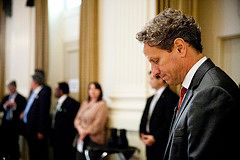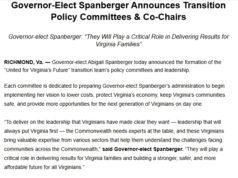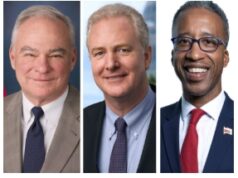 By March 2008, the prospect of a meltdown was looming. Bear Stearns fell first. It started with rumors about investment in sub-prime mortgages, tagged as toxic assets. Bear Stearns bought hundreds of thousands of sub-prime mortgages and bundled them. Little then did candidate Obama know the role he would play.
By March 2008, the prospect of a meltdown was looming. Bear Stearns fell first. It started with rumors about investment in sub-prime mortgages, tagged as toxic assets. Bear Stearns bought hundreds of thousands of sub-prime mortgages and bundled them. Little then did candidate Obama know the role he would play.
This continuation of the Frontline documentary takes up with the events of 2008, a Presidential election year. In this installment, the very foundation of the financial world trembles while we meet the major players: Secretary of the Treasury Hank Paulson, Chairman of the Federal Reserve, Ben Bernanke, and Tim Geithner, president of the Federal Reserve Bank of New York.
Tim Geithner distinguished himself from the moment he received the first panicked call. Instead of acting without intelligence, he dispatched a team to survey the situation at Bear Stearns. They and teams from the SEC and JP Morgan discovered a drowning pool of toxic assets. Bear had made credit default swap deals worth trillions of dollars that had infected all of Wall Street and the financial world. Geither recognized the systemic risk to the world economy. This was the moment of realization that Bear Stearns was too big to fail. This took Federal regulators by surprise.
 At four AM Geithner called Ben Bernanke, Chairman of the Federal Reserve. Bernanke, a student of the Great Depression feared what a lack of confidence could do to the financial sector. He phoned the Secretary of the Treasury the next morning. Paulson had come to that position from the biggest competitor of Bear Stearns. He thought he knew the situation and brought with him the mentality of an investment banker rather than a regulator: The market rewards and the market punishes, so you don’t need a lot of regulation. When push came to shove, despite his professed market philosophy, he was not willing to risk the punishment.
At four AM Geithner called Ben Bernanke, Chairman of the Federal Reserve. Bernanke, a student of the Great Depression feared what a lack of confidence could do to the financial sector. He phoned the Secretary of the Treasury the next morning. Paulson had come to that position from the biggest competitor of Bear Stearns. He thought he knew the situation and brought with him the mentality of an investment banker rather than a regulator: The market rewards and the market punishes, so you don’t need a lot of regulation. When push came to shove, despite his professed market philosophy, he was not willing to risk the punishment.
The Federal Reserve used power that they had but had lain dormant since the Great Depression. They used $30 billion of government money to avoid bankruptcy while Geithner brokered a sale to JP Morgan. Geithner had cut his teeth on matters such as these while an Undersecretary in the Clinton administration working to salvage third world financial crises. It had always worked by flooding the troubled banks with money. This strategy troubled Paulson. In hindsight, he publicly warned of a moral hazard. His message was: “We did this once, but now you are on your own.”
This was in an election year when the Democratic candidate had already made the economy an issue. Barack Obama was out front declaring that we had had eight years if disastrous economic policy. Obama had already chosen the theme that there is a problem in the economy, that his opponent does not see it, and that he (Obama) knew how to fix it. He had an inside Wall Street connection who provided information on a regular basis after the failure of Bear Stearns.
Obama initially took the tact that the situation could be ameliorated by calling out for the ethical high ground among Wall Street executives. In a speech to bankers at Cooper Union, he relayed the message that regulation had to be enforced; it was not well received.
“A free market was never meant to be a free license to take whatever you can get however you can get it.” – candidate Barack Obama at Cooper Union
As the campaign continued, the economic situation did not improve. The lame duck President assigned the task of handling the crisis to Paulson who still suffered the illusion that Bear Stearns was a one of; others would not be that bad. President Bush settled on a message that things were improving, but over time, the indicators they chose as evidence were turned on their heads and one by one fell away from the theme as good news dwindled.
Paulson and Bernanke sounded the consistent theme that the economy would right itself in time. This became known as “The Summer of Assurances.” In the face of strong warnings, Bush remained on message.
“I am not an economist. But I do believe that we are growing. I can remember this press conference…you know, you people yelling recession, recession as if you are economists. And uh, I am an optimist. You know, I believe there’s a lot of positive things for our economy.” – President Bush, July 15 2008
As the summer drew on and the crises became more obvious, the striking feature of policy was the lack of action and how little the people in charge knew. Then came Lehman Brothers. Lehman had bet hundreds of billions of dollars on the mortgage industry. Those bets had soured and all of Wall Street knew it. But moral hazard haunted Paulson. He was raked over the coals before Congress and that further reinforced his position, without due regard to the changing situation.
The heads of Wall Street’s largest firms were summoned to the Federal Reserve on Friday night, September 12th, 2008. In that meeting, Paulson announced that Lehman was in a death spiral and he tasked these CEOs to figure out what to do without government aid. Obama’s inside source was keeping him abreast and holding no punches. The other Wall Street banks would do nothing to rescue Lehman, but Paulson was unmoved. Further, the inaction of the summer left them all without any plan and unprepared for what might follow.
Paulson’s bet that the markets would take care of themselves, one that he had been unwilling to risk during the Bear Stearns crisis, went terribly wrong. The bankruptcy of Lehman sent shockwaves throughout the financial world. Banks quit lending to each other. It spread to manufacturing, companies no longer had liquidity. Business could no longer do business. Geithner heard it over and over throughout the day. Then world’s economic heartbeat flat-lined. The economic Gibraltar of the world, the United States, had sent contradictory messages. There was panic from the confusion in Washington.
Obama was getting constant updates from his team in real time. Actively engaged before Lehman, he became pro-actively engaged. Now the Bush administration reached out to Obama for support. AIG was on the cusp and Obama’s economic advisors were telling him that the failure of AIG could topple the world’s economy. At that same time, Geithner and Paulson began to understand the reality of the AIG situation, just days before its imminent collapse. Geithner was immediately persuaded that another Lehman could not be allowed. Paulson, reeling from Lehman, wavered from his philosophical policy position and changed course, deferring to Geithner. So much for moral hazard. Those lofty principles were discarded in the face of responsibility.
Geithner weighed forcing the banks involved with AIG to take a haircut; discount their policies to absorb part of the hit. But he chose another course. He chose to make them whole to reassure their investors. This bailout was to the tune of $180 billion. Though Geithner orchestrated the bailout in short order, it did not stop the meltdown. The world capital markets collapsed.
Bernanke now went to Paulson and told him he must go to Congress to request a massive bailout rather take this on, on a case by case basis. Congress was completely uninformed. As this happened, the Speaker of the House called Paulson to ask him to appear before Congress. Paulson told her that waiting even to the morning would be too late. He told her that he and Bernanke needed to come to the Hill that afternoon. As Senator Shelby (R-AL) described it, they came in and dropped a bomb on the meeting. Suddenly Paulson was asking Congress to act swiftly on the economic equivalent of shock and awe: an immediate $700 billion bailout.
Republicans in the House of Representatives revolted. In the midst of this, politics intervened, but not in the way the Republican candidate’s strategic team anticipated. John McCain suspended his campaign for the Presidency in response to the crisis. He was going to ride into Washington, call a meeting, and solve everything. There was a very delicate negotiation going on and he threw himself into the middle of his own Party’s administration’s game. He called upon the President to convene a conference which would include both major Party candidates.
 The President convened the called for summit. Bush told the group that they must act to get the money flowing or the economy would fail. McCain walked into the meeting with some file cards, but when Bush opened it up for discussion, Obama did not defer to McCain. Obama was prepared and he jumped right into the conversation, extremely supportive of the bailout. Then he asked to hear from the man who called for the meeting. McCain fumbled around and melted right there. There was no evidence he understood what was happening. Bush leaned over to Nancy Pelosi while McCain was trying and whispered, “You guys are really going to miss me.”
The President convened the called for summit. Bush told the group that they must act to get the money flowing or the economy would fail. McCain walked into the meeting with some file cards, but when Bush opened it up for discussion, Obama did not defer to McCain. Obama was prepared and he jumped right into the conversation, extremely supportive of the bailout. Then he asked to hear from the man who called for the meeting. McCain fumbled around and melted right there. There was no evidence he understood what was happening. Bush leaned over to Nancy Pelosi while McCain was trying and whispered, “You guys are really going to miss me.”
The meeting disintegrated into chaos. Bush got up, expressed that he had lost control of the meeting, and left the room. Another Republican at the table turned to a contemporary and said, “After this, even we are going to vote for Obama.”
This was a turning point in the campaign. Obama showed authority. McCain had promised action and did not seem to have the authority a Commander-in-Chief should have.
It took another week, but the Paulson bill finally passed. The Troubled Asset Relief Program (TARP) was born. In October, the great apostle of the free market and believer in moral hazard, initiated the largest government intervention in Wall Street since the Great Depression. Completely discarding his laissez faire philosophy, he demanded the banks accept the money. Calling the bankers to Washington, he would not allow them to leave until they accepted the TARP funds. In return for the cash, the government took a stake in the banks. The Chairman of Wells Fargo told him that he did not need the money and did not want the money. Paulson’s response: if he did not take the money, on Monday, his bank would be declared capital deficient. The terms were extremely generous and required no specific acts. They did not have to modify practices or put limits on salaries or bonuses. They did not have to do anything differently than they had been doing when they walked into the room.
“When the situation changes, you have to be willing to change with the situation.” – Paulson after the crisis
The Financial Crisis Inquiry Report lays all this out. No one in a position to act understood that this situation threatened the financial sector. Regulators had deliberately turned a blind eye. This was a dark market with no transparency. No Federal or state public officials had any idea how these markets were run. All protestations had been dismissed. The free market had been unleashed to freely and indiscriminately punish all including bystanders.
The Frontline documentary airs the final installment tomorrow, May 1, 2012 on your local Public Broadcasting outlet and online.



![Saturday News: “Trump’s latest tariff TACO probably won’t make your life more affordable”; “The Epstein Email Cache: 2,300 Messages, Many of Which Mention Trump”; “[MTG] questions if Trump is still the ‘America First’ president”; “Jim Ryan tells all: ‘What did the Governor know, when did he know it?’”](https://bluevirginia.us/wp-content/uploads/2025/11/montage1115-238x178.jpg)







![Saturday News: “Trump’s latest tariff TACO probably won’t make your life more affordable”; “The Epstein Email Cache: 2,300 Messages, Many of Which Mention Trump”; “[MTG] questions if Trump is still the ‘America First’ president”; “Jim Ryan tells all: ‘What did the Governor know, when did he know it?’”](https://bluevirginia.us/wp-content/uploads/2025/11/montage1115-100x75.jpg)

